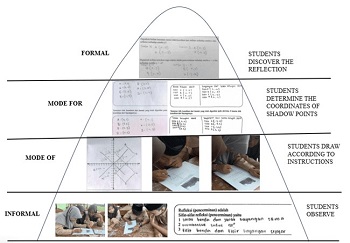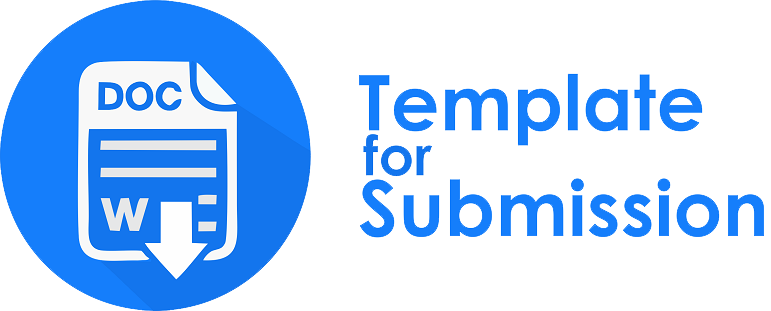HYPOTHETICAL LEARNING TRAJECTORY DESIGN IN REFLECTION LEARNING USING THE CONTEXT OF THE CIREBON RED MOSQUE
Abstract
This research aims to design a reflective learning trajectory using the context of the Cirebon Red Mosque as the starting point or learning context. The method used in this research is design research with stages of preliminary design, design experiment and retrospective analysis. The subjects in this research were several samples of class VIII junior high school students. The results of this research are a hypothetical learning trajectory design in reflective learning using the context of the Cirebon Red Mosque with a learning trajectory, namely students observing pictures from the front gate of the Red Mosque, having discussions and finding the meaning and properties of reflection, students drawing objects with agreed conditions, students record the starting point and ending point of the reflection results and find the relationship between the two and finally, students find the reflection formula. The research results show that a series of activities in the context of the Cirebon Red Mosque have a potential impact on understanding the concept of reflection. Students work on mathematics collaboratively and the learning process becomes meaningful and easy.
Downloads
References
Ambarwati, B., Zulkardi, Z., & Susanti, E. (2023). Kemampuan berpikir reflektif siswa dalam menyelesaikan soal PMRI konteks ornamen jati diri Sumatera Selatan. Delta-Pi: Jurnal Matematika dan Pendidikan Matematika, 12(1), 25-37. https://doi.org/10.33387/dpi.v12i1.5455
Amarta, N., Putri, R. I. I., & Zulkardi, Z. (2023). Students' Numeracy Skills in Learning Cartesian Coordinate System Using PMRI in the Context of Palembang LRT. Jurnal Pendidikan Matematika, 17(3), 325-342. https://doi.org/10.22342/jpm.17.3.20239.325-342
Andriani, S. (2020). Upaya peningkatan kemampuan komunikasi matematis siswa. Journal on Teacher Education, 1(2), 33-38. https://doi.org/10.31004/jote.v1i2.515
Asfyra, I. B., Zulkardi, Z., Somakim, S., Kurniadi, E., Sukmaningtyas, N., Helen, R., ... & Nusantara, D. S. (2023). Pelatihan Pendesaian Perangkat Pembelajaran Berbasis Pendidikan Matematika Realistik Indonesia (Pmri) Di Smk Kelas X Pada Konteks Busana. Pengabdian Masyarakat Pamong, 2(1), 1-7. https://doi.org/10.51517/jpm.v2i1.166
Astari, W. Y., & Rochman, G. P. (2023). Hubungan Timbal Balik antar Aktor dalam Pengembangan Wisata Budaya Keraton Kota Cirebon. Jurnal Riset Perencanaan Wilayah dan Kota, 47-54. https://doi.org/10.29313/jrpwk.v3i1.1950
Domu, I., & Mangelep, N. O. (2020, November). The Development of Students’ Learning Material on Arithmatic Sequence Using PMRI Approach. In International Joint Conference on Science and Engineering (IJCSE 2020) (pp. 426-432). Atlantis Press. https://doi.org/10.2991/aer.k.201124.076
Elisa Anggraini, Z. (2020). Kemampuan Berpikir Kreatif Siswa dalam Mem-posing Masalah menggunakan Pendekatan Pendidikan Matematika Realistik Indonesia. Jurnal Elemen, 6(2). https://doi.org/10.29408/jel.v6i2.1857
Gravemeijer, K. (1994b). Educational Development and Developmental Research in Mathematics Education. Journal for Research in Mathematics Education, 25(5), 443– 471. https://doi.org/10.2307/749485
Gravemeijer, K. (2004). Local Instruction Theories as Means of Support for Teaching in Reform Mathematic Education. Mathematical Thinking and learning, 6(2), 105-128. https://doi.org/10.1207/s15327833mtl0602_3
Gravemeijer, K., & Cobb, P. (2006). Design Research from a Learning Design Perspective. Educational design research. https://doi.org/10.4324/9780203088364-12
Gravemeijer, K., & Eerde, D. van. (2009). Design Research as a Means for Building a Knowledge Base for Teachers and Teaching in Mathematics Education. The Elementary School Journal, 109(5), 510–524. https://doi.org/10.1086/596999
Hamidah, I., & Susilawati, S. (2023). Pembelajaran Matematika Berintegrasi Nilai-Nilai Keislaman Dalam Pembentukan Karakter Siswa. Indonesian Journal of Teaching and Learning (INTEL), 2(1), 29-36. https://doi.org/10.56855/intel.v2i1.143
Hidayat, W., Rohaeti, E. E., Hamidah, I., & Putri, R. I. I. (2023, January). How can android- based trigonometry learning improve the math learning process?. In Frontiers in Education (Vol. 7, p. 1101161). Frontiers. https://doi.org/10.3389/feduc.2022.1101161
Isnaeni, S., Ansori, A., Akbar, P., & Bernard, M. (2019). Analisis kemampuan koneksi matematis siswa SMP pada materi persamaan dan pertidaksamaan linear satu variabel. Journal on Education, 1(2), 309- 316. https://doi.org/10.15575/ja.v6i1.8566
Lailah, S. I., & Hamidah, I. (2023). Identifikasi Kesulitan Siswa SMPIQU Al-Bahjah Pusat dalam Menyelesaikan Soal Operasi Bilangan Bulat dan Pecahan. AB-JME: Al- Bahjah Journal of Mathematics Education, 1(1), 1-10. https://doi.org/10.61553/abjme.v1i1.11
Mulbasari, A. S., Putri, R. I. I., Zulkardi, Z., & Aisyah, N. (2023). Analysis of the Needs of the PMRI Learning Environment for Geometry Material on the Critical Thinking Ability of PGSD Students. JTAM (Jurnal Teori dan Aplikasi Matematika), 7(2), 273- 282. https://doi.org/10.31764/jtam.v7i2.11970
Nuraida, I., & Amam, A. (2019). Hypothetical learning trajectory in realistic mathematics education to improve the mathematical communication of junior high school students. Infinity Journal, 8(2), 247-258. https://doi.org/10.22460/infinity.v8i2.p247-258
Prahmana, R. C. I., & Suwasti, P. (2014). Local instruction theory on division in mathematics GASING. Journal on Mathematics Education, 5(1), 17-26. https://doi.org/10.22342/jme.5.1.1445.17+-+26
Prahmana, R. C. I. (2017). Design research (Teori dan implementasinya: Suatu pengantar). Jakarta: Rajawali Press. (1) (PDF) Design Research (Teori dan Implementasinya: Suatu Pengantar) (researchgate.net)
Ramadhan, M. H., Zulkardi, Z., & Putri, R. I. I. (2022). Designing Learning Trajectory for Teaching Fractions Using PMRI Approach with a Chessboard Context. SJME (Supremum Journal of Mathematics Education), 6(2), 162-170. https://doi.org/10.35706/sjme.v6i2.5866
Risdiyanti, I., & Prahmana, R. C. I. (2018). Desain hypothetical learning trajectory dalam pembelajaran rotasi menggunakan motif batik Kawung. Prima: Jurnal Pendidikan Matematika, 2(1), 19-32. http://dx.doi.org/10.31000/prima.v2i1.411
Safari, N. F. N. (2021). Mathematics make students confused and anxious: A comparisons between Australia, Indonesia, and Singapore in the 2015 TIMSS. Indones. J. Educational Assess. 3, 1–15. https://doi.org/10.26499/IJEA.V3I2.74
Setiawan, E. P., Pierewan, A. C., and Montesinos- López, O. A. (2021). Growth mindset, school context, and mathematics achievement in Indonesia: a multilevel model. J. Mathematics Educ. 12, 279–294. https://doi.org/10.22342/JME.12.2.13690.279-294
Siagian, M. D. (2016). Kemampuan koneksi matematik dalam pembelajaran matematika. MES: Journal of Mathematics Education and Science, 2(1). https://doi.org/10.30743/MES.V2I1.117
Siswoyo, S., & Mardiana, R. (2019). Arsitektur Masjid Sunan Gunung Jati Cirebon sebagai Akulturasi Budaya Islam, Jawa, dan Cina. Jurnal Lingkungan Binaan Indonesia, 8(1), 7-14. http://dx.doi.org/10.32315/jlbi.8.1.56
Zaenuri, Z., & Dwidayanti, N. (2018). Menggali etnomatematika: Matematika sebagai produk budaya. In PRISMA, Prosiding Seminar Nasional Matematika, (1), 471-476. Menggali Etnomatematika: Matematika sebagai Produk Budaya | Semantic Scholar
Zulkardi, Z., Putri, R. I. I., & Wijaya, A. (2020). Two decades of realistic mathematics education in Indonesia. International reflections on the Netherlands didactics of mathematics: Visions on and experiences with Realistic Mathematics Education, 325- 340. https://doi.org/10.1007/978-3-030-20223-1_18

Copyright (c) 2024 Ida Hamidah, Zulkardi Zulkardi, Ratu Ilma Indra Putri, Ely Susanti, Duano Sapta Nusantara

This work is licensed under a Creative Commons Attribution-NonCommercial-ShareAlike 4.0 International License.
License and Copyright Agreement
By submitting a manuscript to Jurnal Pendidikan Matematika (JUPITEK), the author(s) certify and agree to the following terms:
- Originality and Authority: The submitting author is authorized by all co-authors to enter into this agreement. The manuscript describes original work that has not been published previously in a peer-reviewed journal, nor is it under consideration for publication elsewhere.
- Approval: Its publication has been approved by all author(s) and by the responsible authorities of the institutions where the work was carried out.
- Rights: The authors secure the right to reproduce any material that has already been published or copyrighted elsewhere.
- Licensing and Copyright: Authors retain the copyright to their work.
- License Grant: The authors grant Jurnal Pendidikan Matematika (JUPITEK) the right of first publication, with the work simultaneously licensed under the Creative Commons Attribution-NonCommercial-ShareAlike 4.0 International (CC BY-NC-SA 4.0).
- Self-Archiving: Authors are permitted and encouraged to deposit the published version of their article in institutional repositories, on their personal websites, and other academic platforms, with proper acknowledgment of its initial publication in Jurnal Pendidikan Matematika (JUPITEK).





.png)


